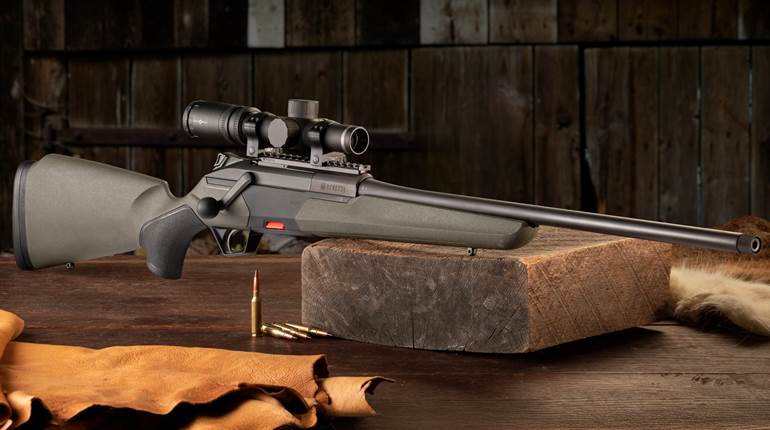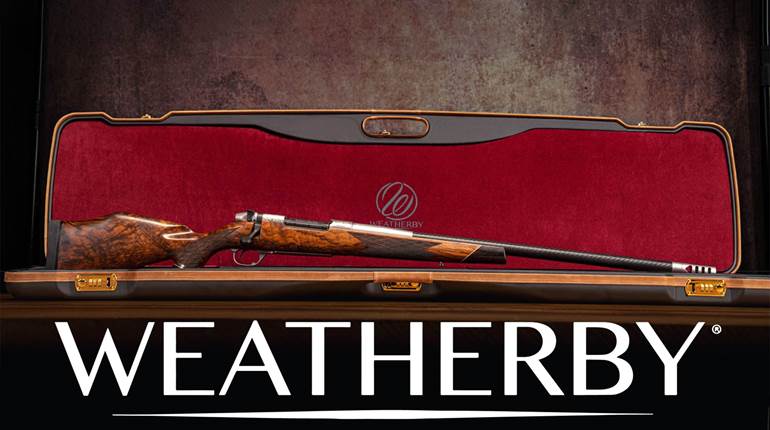
"Nothing shoots flatter, hits harder or is more accurate. Guaranteed.”
There are few rifle enthusiasts and big-game hunters worldwide who wouldn’t recognize the Weatherby slogan. Its purpose, however, is more than to simply serve as a catchword; it’s a promise that drives the company’s decision-making process. A recommitment to those stated qualities served as the catalyst behind Weatherby’s recent decision to bring home, to Paso Robles, Calif., production of the company’s flagship rifle, the Mark V.
Examining The Mark V
Weatherby’s lineage can be traced to the early 1940s, when founder Roy Weatherby began wildcatting cartridges with higher than traditional velocities. It wasn’t until 1954, though, that he began experimenting with an action (and thus a rifle) of his own design. His reason for doing so was two-fold. First, being well-versed in the “workings” of bolt-action rifles, Weatherby found most existing designs lacking, particularly with regard to integrity and therefore safety. He believed that he could create a better action. In addition, he was frustrated by his dealings with the European companies that had previously supplied the company’s actions and rifles.
From 1945 until 1958, the latter being the Mark V’s introductory year, Weatherby utilized existing actions from Fabrique Nationale, Schultz & Larsen, Mathieu and Brevex, among others, as well as customer-supplied rifles re-chambered to accept his proprietary cartridges. Such practices continued until 1961.
Weatherby revealed the first iteration of his action in early 1955, while in Washington, D.C., attending NRA’s Annual Meetings. Encouraged by prominent firearm industry figures of the day, he continued to refine his action until the fifth-and final-variant was transformed into a working rifle. Playing on Mercury Outboard Motor’s use of “Mark” followed by the model designation-suggested by motor boat champion, world renowned hunter, and Weatherby Award winner Elgin Gates-Roy Weatherby coined the fifth prototype of his action/rifle the “Mark V.”
When designing the Mark V action, strength was paramount to Weatherby; in fact, he wanted an action capable of withstanding an unheard of 200,000-copper units of pressure (c.u.p.), whereas most others of the time succumbed around 70,000 c.u.p. He also demanded a means to prevent propellant gasses from reaching the shooter’s face in instances of pierced primers or case-head separation. Subsequent “torture” testing proved the action to be incredibly resilient, and from that came the phrases “The world’s strongest action” and “strongest bolt action ever designed.”
What, exactly, was done to enhance safety? First, the recessed bolt face encloses the cartridge’s case head, and the breech end of the barrel is likewise recessed to accept the forward portion of bolt. Both are surrounded by the receiver ring, providing a total of three layers of steel for added protection.
Weatherby didn’t stop there, however. Several measures were also taken to prevent gas flowback. “Gases flowing around the extractor are deflected by a shoulder located behind the locking lugs,” explains company literature. That’s fine for case-head separation, but what happens to propellant gases vented through a pierced primer? Weatherby included three holes in the bolt body that vent gases out of the loading port. Should gas bypass the openings, the shrouded bolt sleeve directs it downward, away from the shooter.
Lastly, the Mark V’s one-piece forged bolt has three sets of three lugs for nine total (except for non-magnum chamberings, which have three sets of two for six altogether), which, unlike traditional lug designs, do not extend beyond the body’s diameter. Although smaller in size than the lugs of a two-lug (or dual-opposed) bolt, the combined engagement area of the Mark V’s bolt is greater, resulting in additional strength. The lug configuration also enables a shorter, 54-degree bolt lift, as opposed to 90 degrees on a two-lug design, or even 60 degrees for bolts with three large lugs. In addition to faster bolt cycling, it provides greater bolt-to-scope clearance.
The Mark V’s full-diameter bolt has longitudinal flutes spanning nearly the body’s entire length, and their purpose is to reduce surface area and capture debris, both of which facilitate smooth cycling. They’re visually appealing, too. Extraction is provided by a spring-powered unit, and the ejector is of the plunger type. On the right rear portion of the bolt, beside the shroud is the safety, for which Weatherby coined the name “Direct Striker Intervention.” In the rear position, the bolt and firing pin are locked and the sear is disengaged, while the forward position readies the rifle to fire. A series of ribs on the tab enhance purchase, and it is easily manipulated with the thumb. The bolt also has a cocking indicator that projects from the rear, into the tang area.
Although the Mark V’s receiver and all its parts were originally investment cast, all are now, and have long been, machined from forged 4140 chromoly steel. The receiver has an oversize integral recoil lug, and there is no raceway or guide rail in the traditional sense; however, thanks to the full-diameter bolt, there’s minimal side-to-side movement during cycling. Since the barrel is devoid of sights, the receiver is drilled and tapped to accept scope bases. Weights for standard and magnum actions are 25.9 ounces and 35.9 ounces, respectively.
Whereas most Mark V rifles feature hammer-forged, button-rifled Criterion barrels, others, such as the Tactical Response Rifle (TRR) and TRR RC, have Krieger barrels. Depending on the model, the barrel-4140 steel for blued versions, 410 stainless steel on Accumark, Ultra Lightweight and Threat Response Custom Magnum-may (or may not) have longitudinal flutes to both lower weight and enhance heat dissipation via additional exposed surface area. Muzzle crowns are either of the recessed target style or radiused “field” type. Also, some chamberings, such as .30-.378 Wby. Mag., .338-.378 Wby. Mag., .378 Wby. Mag., .416 Wby. Mag. and .460 Wby. Mag., as well as all options in the Mark V Accumark, have Weatherby’s recoil-reducing Accubrake installed. Reportedly, recoil reduction is upward of 53 percent. Thread protectors are provided for when the devices are not used. Brakes can be fitted to any rifle, however, as an option.
The Mark V has an all-steel trigger assembly of the company’s own design. From the factory, sear engagement is set at 0.008 inches to 0.014 inches and trigger pull weight is 3 pounds, 8 ounces, though both settings can be adjusted. There is virtually no discernible creep or overtravel.
Perhaps the most distinguishable feature of a Mark V rifle, from the Accumark and Deluxe to the Synthetic and Light is its raised-comb Monte Carlo-style stock with cast off dimensions. Deluxe, Lasermark, Sporter, Ultramark and Euromark Mark Vs have stocks in standard, select, “AA” fancy-grade or “AAA” exhibition-grade walnut, while the Synthetic has an injection-molded version and the Fibermark Composite, Ultra Lightweight and Accumark have hand-laminated iterations made from a combination of aramid, graphite unidirectional fibers and fiberglass. The latter two have a CNC-machined, 6061-T6 aluminum bedding “plate” molded into the stock that provides a rigid platform for securing the action to the stock, enhancing consistency and accuracy. As for the dual-tapered fore-end, it has a flat bottom for better stability. Capping the buttstock is a pliable Pachmayr Decelerator recoil pad. Finishing out the rifle is a one-piece bottom metal unit with integral trigger guard and drop-out floorplate.
Moving Forward
Weatherby has long guaranteed its Mark V rifles to shoot a 1 1/2-inch, three-shot group at 100 yards from a cold barrel when using Weatherby ammunition; the company proudly boasts that it was the first firearm manufacturer to offer an assurance of performance. However, whereas 1 1/2-inch three-shot groups were once considered extraordinary, such accuracy is now viewed as mediocre, despite being more than acceptable for hunting big-game animals. Today’s shooters demand “sub-m.o.a.” accuracy. In 2005, Weatherby introduced the Vanguard SUB-MOA, guaranteeing its capability of three-shot groups measuring 0.99 inches or less at 100 yards. The gun was later renamed the Vanguard Series 2 Range Certified (RC); however, as of mid-2011, all rifles in the Vanguard line are guaranteed to meet that level of accuracy.
To honor its own pledge (“Nothing … is more accurate”), the company’s flagship rifle, the Mark V, had to be accompanied by a performance guarantee equivalent to its value-priced sibling. Doing so, however, required moving production-once again.
Since the Mark V’s debut, it has been manufactured throughout the world; in fact, the South Gate, Calif., creation was produced only a short time before first heading to West Germany, then to Japan, Saco, Maine, and most recently, Brainerd, Minn. To ensure that an upgraded guarantee-sub-m.o.a.-could be achieved, Mark V production needed to be more tightly controlled, thus necessitating it be moved in-house to Paso Robles, Calif. The move required two years to complete, and due to diligent planning, it occurred flawlessly. Mark V production in Paso Robles began in the fall of 2011.
“We have made a recommitment to the quality of the Mark V, and that’s why we have brought its production back under our roof where we can control every aspect of the manufacturing process,” explained company President Roy Edward “Ed” Weatherby, Jr. “Our Mark V customers take the utmost pride in the quality, fit, finish and features they have come to expect of a Weatherby, as well as knowing that their Mark V was built, assembled and finished in the United States. There is a tremendous sense of pride and accomplishment knowing that every Mark V is built right here in Paso Robles.
“As for our gunsmithing staff, this was an area we knew we’d have to ramp up when bringing the Mark V home,” said Weatherby. “We had a long-time core gunsmithing staff as a solid foundation so when we started adding on we looked for some, pardon the pun, ‘young guns’ to bring in fresh ideas and energy. You will see this reflected in the product line in the near future.”
Concerning accuracy, Weatherby said, “We take accuracy very seriously. The most recent evidence of this is in the Mark V Range Certified (RC), which is a Mark V Accumark that is range certified to shoot sub-m.o.a. Every Mark V RC comes with a target [Oehler Research 83 Ballistic Imaging System printout] proving the rifle’s accuracy. It’s reviewed, certified and signed by me and includes extensive information including the most accurate ammunition for your rifle.”
The Accumark RC is priced at $2,400 for all chamberings except for .30-.378 Wby. Mag., .338 Lapua Mag. and .338-.378 Wby. Mag., which cost $2,700. Other Mark Vs-excluding “custom” variants-range from $1,300 (Synthetic) to $3,100 (Ultramark), though RC versions of these are currently unavailable.
“My father built the company on a foundation of bringing innovation to market,” said Weatherby. “It started with the original line of Weatherby cartridges and we’ve continued to be responsive to our customers by introducing the .30-.378 Wby. Mag. and .338-.378 Wby. Mag. calibers in the 1990s. The .338 Lapua Mag. is a great example of meeting demand for another long-range caliber. And we’re not done yet. We have even more exciting and innovative plans for the future.”
So, is Weatherby’s adage still accurate? “It’s truer today than ever before,” explained Weatherby. “While many companies focus on one aspect, such as accuracy, our rifles and cartridges have proven to be superior because of their ability to shoot flat, hit hard and be consistently accurate.”
Manufacturer: Weatherby, Inc.; (805) 227-2600; www.weatherby.com
Caliber: Weatherby chamberings from .240 Wby. Mag. to .338-.378 Wby. Mag.; .270 Win., .308 Win., .30-’06 Sprg., 7 mm Rem. Mag., .300 Win. Mag., .338 Lapua Mag.; .30-.378 Wby. Mag. (tested)
Action Type: bolt-action, repeating center-fire rifle
Receiver: 4140 steel
Barrel: 24" to 28"; 1:9.5", 1:10" or 1:12" (28", 1:10" tested)
Magazine: box; two-, three- or five-round capacities (depending on chambering); hinged floorplate
Sights: none; drilled and tapped for scope bases
Trigger: adjustable, single-stage; 2-lb., 9-oz. pull
Stock: hand-laminated from aramid, graphite unidirectional fibers and fiberglass; CNC-machined, 6061-T6 aluminum bedding “plate” is molded into the stock: length of pull, 135⁄8"; drop at heel, 1¾"; drop at comb, 3/4".
Overall Length: 44" to 485⁄8" (485⁄8" as tested)
Weight: 71⁄4 lbs. to 9 lbs. (9 lbs. as tested)
Accessories: owner’s manual, lock
Suggested Retail Price: $2,400; $2,700 (.30-.378 Wby. Mag., .338 Lapua Mag., .338-.378 Wby. Mag.)
11/28/2012





































